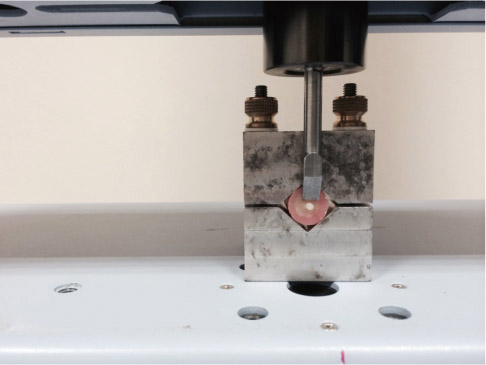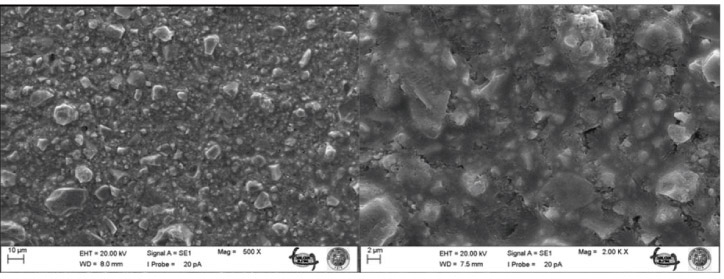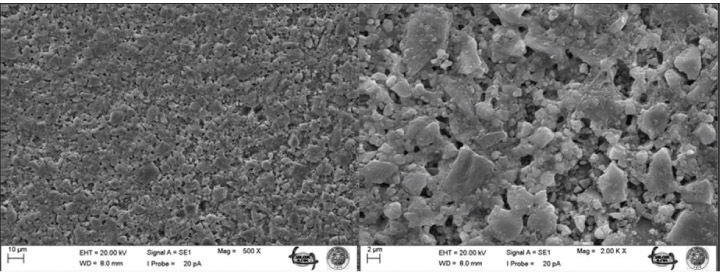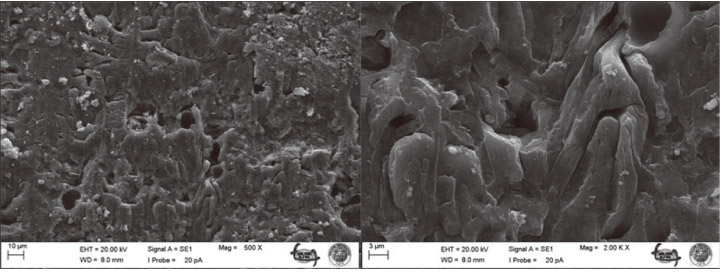J Adv Prosthodont.
2015 Apr;7(2):108-114. 10.4047/jap.2015.7.2.108.
Evaluation of the bond strength between aged composite cores and luting agent
- Affiliations
-
- 1Department of Prosthodontics, Faculty of Dentistry, Gazi University, Ankara, Turkey. drserdarpolat@gmail.com
- 2Department of Restorative, Faculty of Dentistry, Abant Izzet Baysal University, Bolu, Turkey.
- 3Department of Prosthodontics, Faculty of Dentistry, Necmettin Erbakan University, Konya, Turkey.
- 4Department of Prosthodontics, Faculty of Dentistry, Ankara University, Ankara, Turkey.
- 5Department of Prosthodontics, Faculty of Dentistry, Bezmi Alem University, Istanbul, Turkey.
- KMID: 2118240
- DOI: http://doi.org/10.4047/jap.2015.7.2.108
Abstract
- PURPOSE
The aim of this study was to evaluate effect of different surface treatment methods on the bond strength between aged composite-resin core and luting agent.
MATERIALS AND METHODS
Seventy-five resin composites and also seventy-five zirconia ceramic discs were prepared. 60 composite samples were exposed to thermal aging (10,000 cycles, 5 to 55degrees C) and different surface treatment. All specimens were separated into 5 groups (n=15): 1) Intact specimens 2) Thermal aging-air polishing 3) Thermal aging- Er:YAG laser irradiation 4) Thermal aging- acid etching 5) Thermal-aging. All specimens were bonded to the zirconia discs with resin cement and fixed to universal testing machine and bond strength testing loaded to failure with a crosshead speed of 0.5 mm/min. The fractured surface was classified as adhesive failure, cohesive failure and adhesive-cohesive failure. The bond strength data was statistically compared by the Kruskal-Wallis method complemented by the Bonferroni correction Mann-Whitney U test. The probability level for statistical significance was set at alpha=.05.
RESULTS
Thermal aging and different surface treatment methods have significant effect on the bond strength between composite-resin cores and luting-agent (P<.05). The mean baseline bond strength values ranged between 7.07 +/- 2.11 and 26.05 +/- 6.53 N. The highest bond strength of 26.05 +/- 6.53 N was obtained with Group 3. Group 5 showed the lowest value of bond strength.
CONCLUSION
Appropriate surface treatment method should be applied to aged composite resin cores or aged-composites restorations should be replaced for the optimal bond strength and the clinical success.
Keyword
MeSH Terms
Figure
Cited by 1 articles
-
Repair bond strength of composite resin to zirconia restorations after different thermal cycles
Serkan Çınar, Ömer Kırmalı
J Adv Prosthodont. 2019;11(5):297-304. doi: 10.4047/jap.2019.11.5.297.
Reference
-
1. Oilo G. Biodegradation of dental composites/glass-ionomer cements. Adv Dent Res. 1992; 6:50–54.2. Bagheri R, Tyas MJ, Burrow MF. Subsurface degradation of resin-based composites. Dent Mater. 2007; 23:944–951.3. Jaffer F, Finer Y, Santerre JP. Interactions between resin monomers and commercial composite resins with human saliva derived esterases. Biomaterials. 2002; 23:1707–1719.4. Gröger G, Rosentritt M, Behr M, Schröder J, Handel G. Dental resin materials in vivo - TEM results after one year: a pilot study. J Mater Sci Mater Med. 2006; 17:825–828.5. Ferracane JL, Marker VA. Solvent degradation and reduced fracture toughness in aged composites. J Dent Res. 1992; 71:13–19.6. Topcu FT, Sahinkesen G, Yamanel K, Erdemir U, Oktay EA, Ersahan S. Influence of different drinks on the colour stability of dental resin composites. Eur J Dent. 2009; 3:50–56.7. Gordan VV. Clinical evaluation of replacement of class V resin based composite restorations. J Dent. 2001; 29:485–488.8. Taha NA, Palamara JE, Messer HH. Fracture strength and fracture patterns of root-filled teeth restored with direct resin composite restorations under static and fatigue loading. Oper Dent. 2014; 39:181–188.9. Asensio Acevedo R, Suarez-Feito JM, Suárez Tuero C, Jané L, Roig M. The use of indirect composite veneers to rehabilitate patients with dental erosion: a case report. Eur J Esthet Dent. 2013; 8:414–431.10. Christel P, Meunier A, Heller M, Torre JP, Peille CN. Mechanical properties and short-term in-vivo evaluation of yttrium-oxide-partially-stabilized zirconia. J Biomed Mater Res. 1989; 23:45–61.11. Tinschert J, Zwez D, Marx R, Anusavice KJ. Structural reliability of alumina-, feldspar-, leucite-, mica- and zirconiabased ceramics. J Dent. 2000; 28:529–535.12. Wolfart M, Lehmann F, Wolfart S, Kern M. Durability of the resin bond strength to zirconia ceramic after using different surface conditioning methods. Dent Mater. 2007; 23:45–50.13. Ozcan M, Kerkdijk S, Valandro LF. Comparison of resin cement adhesion to Y-TZP ceramic following manufacturers' instructions of the cements only. Clin Oral Investig. 2008; 12:279–282.14. Piconi C, Maccauro G. Zirconia as a ceramic biomaterial. Biomaterials. 1999; 20:1–25.15. Blatz MB, Sadan A, Kern M. Resin-ceramic bonding: a review of the literature. J Prosthet Dent. 2003; 89:268–274.16. Fazi G, Vichi A, Ferrari M. Influence of surface pretreatment on the short-term bond strength of resin composite to a zirconia-based material. Am J Dent. 2012; 25:73–78.17. Blatz MB, Sadan A, Arch GH Jr, Lang BR. In vitro evaluation of long-term bonding of Procera AllCeram alumina restorations with a modified resin luting agent. J Prosthet Dent. 2003; 89:381–387.18. Blatz MB, Chiche G, Holst S, Sadan A. Influence of surface treatment and simulated aging on bond strengths of luting agents to zirconia. Quintessence Int. 2007; 38:745–753.19. Thompson JY, Rapp MM, Parker AJ. Microscopic and energy dipersive x-ray analysis of surface adaptation of dental cements to dental ceramic surfaces. J Prosthet Dent. 1998; 79:378–383.20. Derand T, Molin M, Kvam K. Bond strength of composite luting cement to zirconia ceramic surfaces. Dent Mater. 2005; 21:1158–1162.21. Atsu SS, Kilicarslan MA, Kucukesmen HC, Aka PS. Effect of zirconium-oxide ceramic surface treatments on the bond strength to adhesive resin. J Prosthet Dent. 2006; 95:430–436.22. Burke FJ, Fleming GJ, Nathanson D, Marquis PM. Are adhesive technologies needed to support ceramics? An assessment of the current evidence. J Adhes Dent. 2002; 4:7–22.23. Kobayashi K, Komine F, Blatz MB, Saito A, Koizumi H, Matsumura H. Influence of priming agents on the shortterm bond strength of an indirect composite veneering material to zirconium dioxide ceramic. Quintessence Int. 2009; 40:545–551.24. Komine F, Kobayashi K, Saito A, Fushiki R, Koizumi H, Matsumura H. Shear bond strength between an indirect composite veneering material and zirconia ceramics after thermocycling. J Oral Sci. 2009; 51:629–634.25. Komine F, Kobayashi K, Blatz MB, Fushiki R, Koizuka M, Taguchi K, Matsumura H. Durability of bond between an indirect composite veneering material and zirconium dioxide ceramics. Acta Odontol Scand. 2013; 71:457–463.26. Armstrong S, Geraldeli S, Maia R, Raposo LH, Soares CJ, Yamagawa J. Adhesion to tooth structure: a critical review of "micro" bond strength test methods. Dent Mater. 2010; 26:e50–e62.27. Román-Rodríguez JL, Fons-Font A, Amigó-Borrás V, Granell-Ruiz M, Busquets-Mataix D, Panadero RA, Solá-Ruiz MF. Bond strength of selected composite resin-cements to zirconium-oxide ceramic. Med Oral Patol Oral Cir Bucal. 2013; 18:e115–e123.28. Ozcan M, Barbosa SH, Melo RM, Galhano GA, Bottino MA. Effect of surface conditioning methods on the microtensile bond strength of resin composite to composite after aging conditions. Dent Mater. 2007; 23:1276–1282.29. Özel Bektas Ö, Eren D, Herguner Siso S, Akin GE. Effect of thermocycling on the bond strength of composite resin to bur and laser treated composite resin. Lasers Med Sci. 2012; 27:723–728.30. Cho SD, Rajitrangson P, Matis BA, Platt JA. Effect of Er,Cr:YSGG laser, air abrasion, and silane application on repaired shear bond strength of composites. Oper Dent. 2013; 38:E1–E9.31. Shahdad SA, Kennedy JG. Bond strength of repaired anterior composite resins: an in vitro study. J Dent. 1998; 26:685–694.32. Nilsson E, Alaeddin S, Karlsson S, Milleding P, Wennerberg A. Factors affecting the shear bond strength of bonded composite inlays. Int J Prosthodont. 2000; 13:52–58.33. Lewis G, Johnson W, Martin W, Canerdy A, Claburn C, Collier M. Shear bond strength of immediately repaired lightcured composite resin restorations. Oper Dent. 1998; 23:121–127.34. Kimyai S, Mohammadi N, Navimipour EJ, Rikhtegaran S. Comparison of the effect of three mechanical surface treatments on the repair bond strength of a laboratory composite. Photomed Laser Surg. 2010; 28:S25–S30.35. Lizarelli Rde F, Moriyama LT, Bagnato VS. Ablation of composite resins using Er:YAG laser-comparison with enamel and dentin. Lasers Surg Med. 2003; 33:132–139.36. Shimizu Y, Tada K, Seki H, Kakuta K, Miyagawa Y, Shen JF, Morozumi Y, Kamoi H, Sato S. Effects of air polishing on the resin composite-dentin interface. Odontology. 2014; 102:279–283.37. Rinaudo PJ, Cochran MA, Moore BK. The effect of air abrasion on shear bond strength to dentin with dental adhesives. Oper Dent. 1997; 22:254–259.38. Salerno M, Giacomelli L, Derchi G, Patra N, Diaspro A. Atomic force microscopy in vitro study of surface roughness and fractal character of a dental restoration composite after air-polishing. Biomed Eng Online. 2010; 9:59.39. Swift EJ Jr, Cloe BC, Boyer DB. Effect of a silane coupling agent on composite repair strengths. Am J Dent. 1994; 7:200–202.40. Burnett LH Jr, Shinkai RS, Eduardo Cde P. Tensile bond strength of a one-bottle adhesive system to indirect composites treated with Er:YAG laser, air abrasion, or fluoridric acid. Photomed Laser Surg. 2004; 22:351–356.41. Lucena-Martín C, González-López S, Navajas-Rodríguez de Mondelo JM. The effect of various surface treatments and bonding agents on the repaired strength of heat-treated composites. J Prosthet Dent. 2001; 86:481–488.42. Keski-Nikkola MS, Alander PM, Lassila LV, Vallittu PK. Bond strength of Gradia veneering composite to fibre-reinforced composite. J Oral Rehabil. 2004; 31:1178–1183.43. Lizarelli RFZ, Moriyama LT, Jorge JRP, Bagnato VS. Comparative ablation rate from a Er: YAG laser on enamel and dentin of primary and permanent teeth. Laser Phys. 2006; 16:849–858.44. Lizarelli RFZ, Moriyama LT, Pelino JEP, Bagnato VS. Ablation rate and morphological aspects of composite resins exposed to Er: YAG laser. J Oral Laser App. 2005; 5:151–160.
- Full Text Links
- Actions
-
Cited
- CITED
-
- Close
- Share
- Similar articles
-
- The influence of fitness and type of luting agents on bonding strength of fiber-reinforced composite resin posts
- Comparison between a bulk-fill resinbased composite and three luting materials on the cementation of fiberglass-reinforced posts
- The shear bond strength of two adhesives bonded to composite resin and glass ionomer cement restorations
- Comparative evaluation of micro-shear bond strength between two different luting methods of resin cement to dentin
- Effect of liners and primers on tensile bond strength between zirconia and resin-based luting agent








